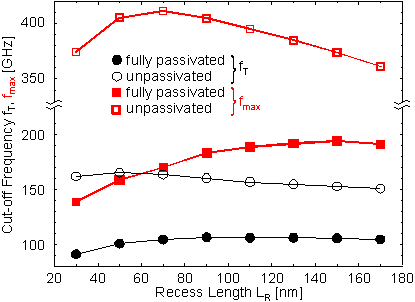
6.3.2.4 Dependence of fT
and fmax on LR
For further improvements of the RF characteristics of the millimeter
wave HEMTs the dependence on LR are investigated. In
Figure
6.48 fT and fmax is shown for passivated
and unpassivated devices. fmax was calculated with the
same assumptions made in Section 6.1.2.3.

For passivated devices fT is increased significantly from 91 GHz for LR = 30 nm to 106 GHz for LR = 90 nm. Only a minor reduction to fT = 104 GHz for LR = 170 nm can be observed. The improvement of fmax due to an increased LR is even larger. The calculated fmax is 138 GHz and reaches a maximum of 194 GHz at LR = 150 nm. Again the maximum of fT is reached for smaller LR than the maximum in fmax due to the larger impact of CGD on fmax compared to its impact on fT.
The maxima of both fT and fmax are
shifted to smaller LR if the coupling between the contacts
is reduced, and, even more important, the values are increased substantially.
As discussed before, non passivated devices with the same DC characteristics
as passivated devices mark a theoretical upper limit for the RF performance.
But some of the improvements can again be obtained by thinning down the
thickness of the passivation layers.
Helmut Brech 1998-03-11